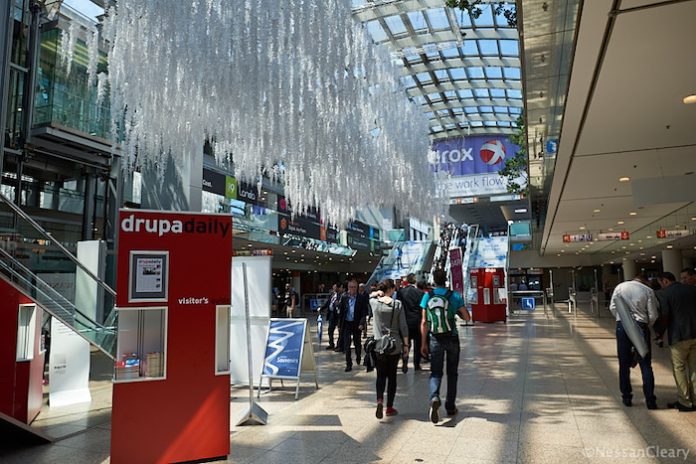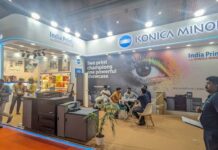
A few months from now many of us will be heading to Düsseldorf in Germany for the Drupa trade show. The show will dominate this year with vendors, printers and journalists all having to arrange our calendars around it. There will be extensive coverage in the trade press, matched only by the accompanying marketing and advertising. But what does Drupa mean for the print industry at large and is it still relevant to modern printers?
These questions are particularly pertinent given that it’s been eight years since the last Drupa show. The 2020 show was cancelled, along with everything else, in the midst of the pandemic and the virtual Drupa that replaced it was a shadow of what the show should be. Many people questioned whether or not the pandemic would mark the end of trade fairs, which have become increasingly hard for exhibitors to justify the costs, and for visitors to find the time.
But when the lockdowns lifted and the trade fairs resumed I was struck by just how much people really did need to travel and to meet with colleagues, suppliers, friends and even rivals. And Drupa is one of the few events that allow us to do that on a truly international level, pulling in visitors and exhibitors from China and Japan as well as India alongside North America and of course Europe.
Drupa, short for Druck Und Papier, or Print and Paper, dates back to 1951. It succeeded an earlier trade show, Bugra, which dealt with books and graphics and had been established in Leipzig in 1914. However, the partition of Germany after WW2 left Leipzig in the East behind the Iron Curtain so the decision was taken to set up a new show in Dusseldorf. That first Drupa attracted some 460 exhibitors, 80 of them from other countries, with the main highlight being the original Heidelberger Tiegel, a platen press producing 5500 sheets per hour.

Subsequent shows have charted the major developments in printing technology, including the move from letterpress to offset printing, the growth of automation in prepress, the birth of the Job Definition Format, and more recently the introduction of digital, first with toner and now with inkjet presses. The early shows were still dominated by book printing, but this has given way to the broad range of commercial printing and in recent years we have seen packaging print becoming more important. This year’s event will continue to explore newer applications around industrial printing, particularly textile printing, as well as 3D printing.
Inevitably there will be a few surprises as the various vendors vie to wow visitors with new launches. And there will likely be a lot of prototypes on show as vendors look to gauge market reaction. It’s too early to predict specific items but we can fill in some of the broad brushstrokes.
For a start, I’m aware of a number of new printheads that will be announced this year, which will give us an indication of where those head manufacturers see the market heading. I would also expect some vendors to show new devices using those heads that have been introduced in the last two years, such as the Xaar Aquinox and Epson D3000.
Some vendors have already announced their intentions. Ricoh, for example, has said that it will use the show to demonstrate both of its recently announced inkjet presses, the Z75 sheetfed and the VC80000 continuous feed printers. Canon is likely to show off the new single pass LabelStream LS2000 label press and VarioPrint iX1700 production printers that it showed in Japan at the end of last year, both of which use its own thermal inkjet technology. Fujifilm will bring its Revoria toner presses, including the new B2-sized GC12500 that I last covered as a prototype from IGAS 2022.
There should also be several single pass inkjet presses designed for printing to flexible film. Fujifilm has announced its FP790, which is based on the Miyakoshi MJP30AXF. Screen had planned to show its Truepress Pac830F at the cancelled 2020 Drupa so I’d expect to see this in Dusseldorf. Screen might even get around to finishing off and launching its Pac520P press for paper-based packaging, having shown the prototype off at several European shows in 2023.

I’ve not heard much from Landa recently, but given that the company has long promised to release a nanographic press for flexible film, and Benny Landa’s predilection for big announcements at Drupa, I would expect to see this at Drupa. Overall, I would expect that we are going to hear a lot more about sustainability in packaging but to make any real impact this has to mean more than just switching from conventional to digital printing.
Kyocera Document Solutions, together with Screen, showed off a prototype A3 inkjet press, the TaskAlfa Pro 55000c/ Screen S320, at last year’s Printing United, so I would be surprised if we don’t see this at Drupa. Equally I would hope to hear more from Kyocera’s Nixka Inkjet Systems subsidiary, which recently introduced its Genix 1200 inkjet print engine.
We’re also likely to see a lot more effects and postpress solutions as printers increasingly look to add value to avoid having to compete simply on price. This could include more enhancements from companies such as MGI, Scodix and Kurz, as well as more digital finishing from vendors such as Highcon.
The other big story is likely to be software, with more diverse workflows, particularly around packaging from vendors such as EFI and Hybrid Software. I expect more vendors will show subscription-based services, particularly around workflows and analytics, though I’m not convinced that such services will help printers reign in costs.
Inevitably there will be a lot of talk around the benefits of AI, particularly in areas such as machine set-ups and predictive maintenance as vendors look to take out much of the cost of training to answer the continuing complaints from many printers of difficulties in recruiting skilled staff.
Media coverage
A number of vendors have asked my advice about when to time their Drupa announcements. There’s an obvious desire to make a big splash at the show but I think the most important consideration is to flag new products as early as possible to give potential customers time to plan their travel to the show, and to make the best use of their time there. After all, shows like Drupa are about showing, and hopefully selling, new products, not playing cat and mouse games with journalists. Besides, nobody wants to bring new products to Drupa and then find that half the potential customers didn’t know those products were there. As it is we will see a flurry of announcements in mid-March as vendors try to hit the May issues of the trade magazines, which will all go to press in April.

There will hundreds, if not thousands, of new products at Drupa. Many of these will be written about in the coming months leading up to Drupa, with the big ticket items – typically new presses – getting a further follow-up at the show.
In my experience, many vendors will feel that they didn’t get the coverage they were expecting in the trade press at the show itself and will send out press releases long after Drupa has closed its doors to announce those products that they failed to flag effectively to journalists before the show, and which no longer count as news.
That brings us to the fact that many journalists will only be at the show for a couple of days or so and very few are going to hang around for the whole event. This is because a) it’s just too expensive to stay for long in Dusseldorf, and b) the value of these big shows, for magazine publishers, lies in the advertising before the show, which ends when the show starts.
This doesn’t affect me since I’m not selling advertising. And since I’m planning on being at the show for the first week and on writing more in-depth features, I’m open to licensing stories to any publishers who would prefer to avoid paying a fortune in Dusseldorf hotel fees.
Visiting the show
The best advice that I can give anyone is to wear comfortable shoes and consult the floor plan before agreeing to any appointments. The show covers a huge area and you can easily find yourself walking many miles back and forth from one meeting to another. And bring an umbrella as there are frequent heavy downpours at this time of year in Germany and you can easily get drenched running between halls! Other than that, everything will take longer than expected, because of the distance between halls, the queues for food and drinks, and just the sheer number of other visitors in the walkways.

Photo Nessan Cleary
Most people will work from a list of things they want to see, and it’s certainly good to have some kind of a structure to your visit to get the most out of the show. But don’t forget to leave time to just wander around – much of the value of Drupa lies in the unexpected things. Plus, there will be plenty of smaller companies lining the sides of each hall, that don’t get much coverage in the trade press, but they nonetheless have developed interesting and useful solutions.
After the show
Inevitably, Drupa will be followed by much debate as to whether or not it was a success and all the effort put into it was worthwhile. There’s no simple way to measure this because a large event like Drupa means different things to each of us. The crudest metrics will be the number of exhibitors and visitors, but this won’t tell us the value of the show to those people. Obviously Messe Dusseldorf will measure the degree of profit in deciding how to organise future Drupas. And each of the exhibitors will match their costs against their sales expectations though it’s hard to attribute which factors ultimately lead to individual sales.
An overview of the Canon stand at Drupa 2016 Photo Nessan Cleary
We could measure the number of products launched, or prototypes shown, or even the media coverage that follows after the show when such coverage is no longer driven by all the marketing heat.
But the real value of these shows lies in the exchange of ideas and the information gathered and that’s almost impossible to measure. That’s just as true for customers making purchasing decisions as it is for vendors looking for trends and journalists searching out stories. In pure financial terms I will almost certainly make a loss as it’s almost impossible to sell enough stories to cover the costs of travel and accommodation. But hopefully the people that I meet, the interviews, conversations and debates and the overall flow of information will make it worthwhile. And of course there’s always the spargel to look forward to.
In the meantime, there’s still this year’s Fespa to deal with first.
First published in the Print and Graphics Journal of 23rd January 2024 www.nessancleary.co.uk









